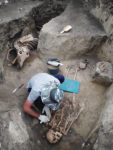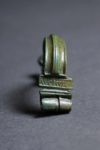 A grave containing the remains of an Alan woman lavishly adorned with Roman jewelry has been unearthed in the Zayukovo-2 burial ground in Kabardino-Balkaria in Russia’s North Caucasus region. She was found in a group grave, probably a family tomb, along with three other men. Artifacts found inside the graves date it to the 1st century or early 2nd.
A grave containing the remains of an Alan woman lavishly adorned with Roman jewelry has been unearthed in the Zayukovo-2 burial ground in Kabardino-Balkaria in Russia’s North Caucasus region. She was found in a group grave, probably a family tomb, along with three other men. Artifacts found inside the graves date it to the 1st century or early 2nd.
“She had two rings on her fingers manufactured with the use of quite a complex technology,” said archaeologist Anna Kadieva, head of an expedition at Zayukovo-2 burial site.
Ms Kadieva said the fact the jewelry was Roman-made is “beyond any doubt.”
She added: “It is quite expensive for the time, and priceless for the barbarian world because there was no glass production in the North Caucasus back then.”
The beads on her shoes were made of glass but also contained an orange-colored mineral called carnelian that is part of the Quartz family.
She also wore two rings on her fingers manufactured with the use of quite a complex technology. Each of them was cast from transparent white glass with golden fibers from the same material, with a dark glass
installation in the middle[…]
The woman was also discovered wearing a bright violet amethyst medallion as seen in this picture. The team say this would have been ‘priceless’ for the region as they had no glass blowing technology at the time
Archaeologists think she was the wife or close family member of an important warrior or chieftain. The sheer density of expensive imported jewelry is evidence of significant wealth, and may represent a trend among the elite Alan warrior class of gifting Roman jewelry to their nearest and dearest. Or maybe she was just lucky.
 One of the men in the grave with her was buried with accessories indicating he was a warrior. A fibula of the Aucissa type, a hinged brooch with a high semi-circular arched bow that attached to a foot. The type is named after the word “AVCISSA” inscribed over the hinge of most of these fibulae. It is the maker’s mark of a workshop that mass-produced them starting in the 1st century A.D.; Aucissa fibulae have been found most often in the graves of Roman soldiers.
One of the men in the grave with her was buried with accessories indicating he was a warrior. A fibula of the Aucissa type, a hinged brooch with a high semi-circular arched bow that attached to a foot. The type is named after the word “AVCISSA” inscribed over the hinge of most of these fibulae. It is the maker’s mark of a workshop that mass-produced them starting in the 1st century A.D.; Aucissa fibulae have been found most often in the graves of Roman soldiers.
The deceased was also buried wearing two Roman buckles in silver and bronze, one on each shoe. A horse bridle with cheek pieces attached to the ends of the bit found in the grave was also of Roman manufacture. It’s possible these were spoils of battle, but archaeologists believe it’s more likely this was a local warrior who fought for Rome.
 In the 1st century, the Alani migrated westward to the Pontic steppe and settled north of the Caucasus. Incursions south into Sarmatian territory in the foothills of the Caucasus resulted in cultural interchange seen in the funerary practices. Some of the Alan burials in Zayukovo-2 have Sarmatian features as well as their own culturally distinctive ones.
In the 1st century, the Alani migrated westward to the Pontic steppe and settled north of the Caucasus. Incursions south into Sarmatian territory in the foothills of the Caucasus resulted in cultural interchange seen in the funerary practices. Some of the Alan burials in Zayukovo-2 have Sarmatian features as well as their own culturally distinctive ones.